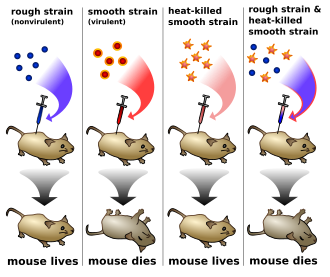Griffith's experiment
Griffith's Experiment
Griffith's Experiment, conducted by Frederick Griffith in 1928, was a pivotal study in the field of genetics that demonstrated the phenomenon of bacterial transformation. This experiment provided the first indication that DNA could be the molecule responsible for heredity.
Background
In the early 20th century, the nature of the genetic material was unknown. Scientists were debating whether proteins or nucleic acids were the carriers of genetic information. Griffith's work with Streptococcus pneumoniae, a bacterium that causes pneumonia, was instrumental in shifting the focus towards nucleic acids.
The Experiment
Griffith used two strains of Streptococcus pneumoniae: the S strain, which was virulent and had a smooth appearance due to its polysaccharide capsule, and the R strain, which was non-virulent and had a rough appearance.
Procedure
Griffith conducted a series of experiments on mice:
- Injection of S strain: Mice injected with the live S strain developed pneumonia and died.
- Injection of R strain: Mice injected with the live R strain remained healthy.
- Injection of heat-killed S strain: Mice injected with heat-killed S strain remained healthy.
- Injection of R strain and heat-killed S strain: Mice injected with a mixture of live R strain and heat-killed S strain developed pneumonia and died.
Results
The surprising result was that the non-virulent R strain had been "transformed" into a virulent form by some "transforming principle" from the heat-killed S strain. This suggested that the genetic information from the dead S strain was taken up by the live R strain, enabling it to produce a capsule and become virulent.
Significance
Griffith's Experiment was significant because it suggested that the "transforming principle" was a molecule that could transfer genetic information. This laid the groundwork for later experiments by Oswald Avery, Colin MacLeod, and Maclyn McCarty, who identified DNA as the "transforming principle."
Related Pages
Transform your life with W8MD's budget GLP-1 injections from $125.
W8MD offers a medical weight loss program to lose weight in Philadelphia. Our physician-supervised medical weight loss provides:
- Most insurances accepted or discounted self-pay rates. We will obtain insurance prior authorizations if needed.
- Generic GLP1 weight loss injections from $125 for the starting dose.
- Also offer prescription weight loss medications including Phentermine, Qsymia, Diethylpropion, Contrave etc.
NYC weight loss doctor appointments
Start your NYC weight loss journey today at our NYC medical weight loss and Philadelphia medical weight loss clinics.
- Call 718-946-5500 to lose weight in NYC or for medical weight loss in Philadelphia 215-676-2334.
- Tags:NYC medical weight loss, Philadelphia lose weight Zepbound NYC, Budget GLP1 weight loss injections, Wegovy Philadelphia, Wegovy NYC, Philadelphia medical weight loss, Brookly weight loss and Wegovy NYC
|
WikiMD's Wellness Encyclopedia |
| Let Food Be Thy Medicine Medicine Thy Food - Hippocrates |
Medical Disclaimer: WikiMD is not a substitute for professional medical advice. The information on WikiMD is provided as an information resource only, may be incorrect, outdated or misleading, and is not to be used or relied on for any diagnostic or treatment purposes. Please consult your health care provider before making any healthcare decisions or for guidance about a specific medical condition. WikiMD expressly disclaims responsibility, and shall have no liability, for any damages, loss, injury, or liability whatsoever suffered as a result of your reliance on the information contained in this site. By visiting this site you agree to the foregoing terms and conditions, which may from time to time be changed or supplemented by WikiMD. If you do not agree to the foregoing terms and conditions, you should not enter or use this site. See full disclaimer.
Credits:Most images are courtesy of Wikimedia commons, and templates, categories Wikipedia, licensed under CC BY SA or similar.
Translate this page: - East Asian
中文,
日本,
한국어,
South Asian
हिन्दी,
தமிழ்,
తెలుగు,
Urdu,
ಕನ್ನಡ,
Southeast Asian
Indonesian,
Vietnamese,
Thai,
မြန်မာဘာသာ,
বাংলা
European
español,
Deutsch,
français,
Greek,
português do Brasil,
polski,
română,
русский,
Nederlands,
norsk,
svenska,
suomi,
Italian
Middle Eastern & African
عربى,
Turkish,
Persian,
Hebrew,
Afrikaans,
isiZulu,
Kiswahili,
Other
Bulgarian,
Hungarian,
Czech,
Swedish,
മലയാളം,
मराठी,
ਪੰਜਾਬੀ,
ગુજરાતી,
Portuguese,
Ukrainian
Contributors: Prab R. Tumpati, MD

